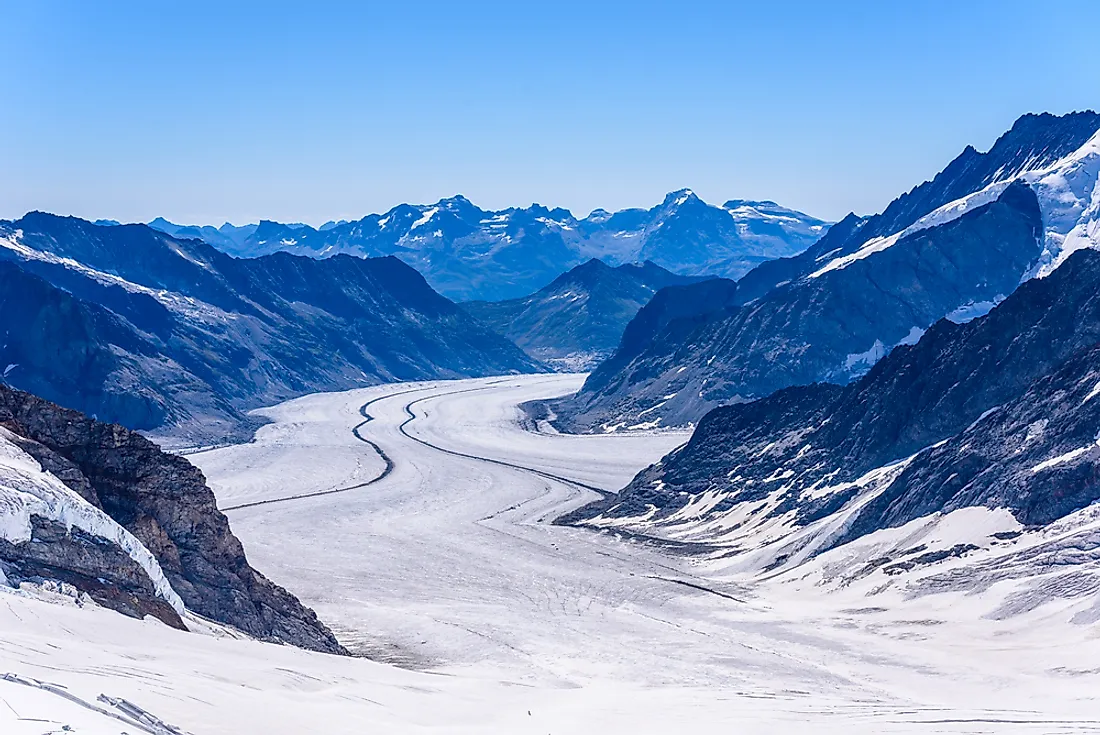The Aletsch Glacier - The Largest Glacier In The Alps

The Aletsch Glacier is the longest and largest glacier in the Alps. It is found in the Bernese Alps in Switzerland. The glacier is a remnant of the ice age dating back to more than 12,000 years ago. The glacier covers 66 square miles and is comprised of the main aletsch, the upper aletsch, and the middle branches. The thickness at the source of the glacier is about 3,000 feet thick while the thickness at the Rhone Valley is about 500 feet. The foot of the aletsch glacier is about 5,118 feet above the sea level. The main glacier which is also referred to as the great aletsch is 1 mile wide and 15 miles long. It stretches from the Concordia Platz and reaches the edge of the aletsch forest. The middle aletsch glacier stretches from the Aletschhorn peak and reaches the main glacier and almost opposite to the Marjelen Lake which borders the Great Aletsch. Two dark strips also known as the medial moraines run on the glacier’s surface and are as a result of merging of the main glacier with the other glaciers. The medial moraines are comprised of debris which is pushed along with the glaciers.
Importance Of The Glacier
The glacier serves as a vast water reserve which is important for hydroelectric power generation and irrigation. Melt-water from the glacier forms the Massa River which is a tributary of the Rhone River. Scientific studies conducted on the glacier have aided in the generation of knowledge on the history of our planet and its ecosystems. The glacier also provides a valuable learning resource while studying the effects on climate change.
Tourism
Aletsch glacier is part of the Jungfrau-Aletsch, which is a protected area and it was listed by UNESCO in 2001 as a natural World Heritage Site due to its elegance. The glacier is a major tourist attraction with visitors getting to enjoy an up-close view on the trail that runs from Riederalp to Fiescheralp on the northern side of the Aletsch-Arena. Tourists following the trail get through the Aletsch Forst to reach the edge of the glacier when their ice-cold experience begins. Tourist going to the area could also enjoy paragliding and hand gliding over the ice.
Threats To The Glacier
The glacier has retreated almost 1.9 miles since 1870. The retreat of the glacier has in recent years increased just like other glaciers around the world due to climate change. The buildup of greenhouse gasses from cars, power-plants, and factories has been blamed for global warming. Glaciology experts have warned that the Aletsch glacier may lose up to 90% of its ice volume by 2100. The next generation of adventurers is likely to have very different scenery in the Alps. The rising temperatures mean that a significant volume of ice during the summer melts compared to what is replenished by ice formation during winter. Rapid generation of melt-water leads to the rise of sea levels which may threaten lowlands in other parts of the world. The sea levels have already risen by an estimated 7.87 inches since 1900. According to a panel of United Nations scientists, the sea levels are expected to rise by between 10.2 and 32.3 inches by the end of the 21st century.











